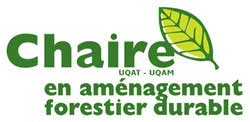Responsable
Louis Imbeau
Collaborateurs
Pierre Drapeau, Marc Mazerolle, Marianne Cheveau, Pauline Suffice
Étudiants
Nathan Chabaud
Problématique
La Stratégie d’aménagement durable des forêts (SADF) propose de développer des modèles de qualité de l’habitat (MQH) pour certaines espèces fauniques sensibles à l’aménagement forestier. Ces MQH seront inclus dans les futurs plans d’aménagement forestier intégré (PAFI) ainsi que dans le calcul des possibilités forestières. Le pékan est une espèce piégée d’intérêt socio-économique, mais elle est aussi identifiée dans la liste des espèces sensibles à l’aménagement forestier d’intérêt provincial (zone forestière de l’érablière). Cependant, nous ne possédons que peu de connaissances locales (au Québec) des besoins en habitat de cette espèce.
Objectifs
Afin de développer un MQH pour le pékan applicable aux conditions forestières du Québec, nous devons aussi acquérir des connaissances ciblées sur les habitats et les attributs d’habitats essentiels, des sites de mise bas et de repos qui sont reconnus comme étant des habitats limitants pour le maintien de l’espèce. Cette approche nécessite la capture et le suivi d’individus marqués.
Méthodologie
En 2020-2021 et 2021-2022, nous avons capturé 31 pékans à l’aide de cages Comstock sur un réseau de sites au Témiscamingue. Les animaux capturés ont été manipulés à l’aide d’un cône en tissu, anesthésiés, sexés, âgés et identifiés à l’aide de transpondeurs passifs. Trente individus ont été munis de colliers, une vingtaine ont collecté des positions GPS et ont transféré des positions et autres données via le système satellitaire Iridium ou Globalstar.
Retombées escomptées
Nos travaux permettront d’acquérir des connaissances qui contribueront directement au développement d’un modèle de qualité d’habitat ciblé sur les caractéristiques clés d’habitat du pékan et d’en faire le lien avec la planification forestière. Nous viserons plus particulièrement à établir quels types de peuplements constituent des habitats recherchés par cette espèce et quels sont les effets des principaux types de traitements sylvicoles sur ces derniers. Les résultats scientifiques contribueront ainsi à paramétrer le modèle de qualité de l’habitat du pékan en forêt feuillue, espèce considérée sensible à l’aménagement forestier.
Applicabilité
Sapinière à bouleau jaune
Livrables
Pauline Suffice, Marianne Cheveau, Marc Mazerolle, Louis Imbeau, Hugo Asselin, Pierre Drapeau. Habitat, Climate, and Fisher and Marten Distributions. 2020. Journal of Wildlife Management 84(2):277-292
DOI : 10.1002/jwmg.21795
Since the mid?twentieth century, fisher populations (Pekania pennanti) increased in several eastern jurisdictions of North America, particularly in the northern part of the species’ range. Changes in fisher distribution have led to increased overlap with the southern portion of the range of American marten (Martes americana), whose populations may be locally declining. This overlap occurs particularly in habitats undergoing natural and anthropogenic modification. The objective of our study was to determine the respective effects of habitat changes and climatic conditions on fisher and marten populations in Quebec, Canada, based on trapper knowledge. We analyzed annual fisher and marten harvest (number of pelts sold/100?km2) between the 1984–1985 and 2014–2015 trapping seasons using linear mixed models. Fisher harvest increased with the increased abundance of mixed forests >12?m tall, resulting from decades of forest harvesting. Fisher harvest decreased with increasing spring rains, which can affect survival when rearing young. Marten harvest decreased with increasing winter rains, which lower thermoregulation capacity and hamper movements by creating an ice crust on the snowpack, reducing access to subnivean areas. Decline in marten harvest during the 30?year study period coincided with an increase in fisher harvest, suggesting possible interspecific competition. Results highlight that managers should strive to maintain mixedwood stands taller than 12?m to maintain high quality habitat for fishers. Our study confirms the importance of working with trappers to assess furbearing population trends in response to habitat changes and climatic conditions. © 2019 The Wildlife Society.
Pauline Suffice, Marc Mazerolle, Louis Imbeau, Marianne Cheveau, Hugo Asselin, Pierre Drapeau. Site occupancy by American martens and fishers in temperate deciduous forests of Québec. 2023. Journal of mammalogy 104(1):159-170
DOI : 10.1093/jmammal/gyac092
Interspecific interactions can mediate site occupancy of sympatric species and can be a key factor in habitat use patterns. American martens (Martes americana) and Fishers (Pekania pennanti) are two sympatric mesocarnivores in eastern North American forests. Due to their larger size, fishers have a competitive advantage over martens. We investigated site occupancy of martens and fishers in temperate deciduous forests of Québec, an environment modified by forest management and climate change. We formulated hypotheses on the spatial distribution of the studied species based on the knowledge of local trappers and on the scientific literature regarding forest cover composition, habitat fragmentation, and competitive relationships. We used a network of 49 camera traps monitored over two fall seasons to document site occupancy by both species. We used two-species site occupancy models to assess habitat use and the influence of fishers on martens at spatial grains of different sizes. None of the habitat variables that we considered explained site occupancy by fishers. Availability of dense old coniferous stands explained the spatial distribution of martens both at the home range grain size and at the landscape grain size. We identified the characteristics of habitat hotspots based on the knowledge of trappers, which highlighted the importance of stand composition, height, age, and canopy closure. The characteristics of habitat hotspots for martens in temperate deciduous forests refine the habitat suitability model for American martens that was originally developed for boreal forests of Québec.
Pauline Suffice, Marc J. Mazerolle, Louis Imbeau, Marianne Cheveau, Hugo Asselin et Pierre Drapeau. 2023. Site occupancy by American marten and fisher in temperate deciduous forest of Quebec. Journal of Mammalogy 104(1): 159-170.
Avancement
Les travaux de terrain sont terminés, l'analyse des domaines vitaux et des habitats utilisés par les pékans est en cours.
Organismes subventionnaires
MFFP, Coopérative, CRSNG-RDC, Fondation de la Faune du Québec
Financement annuel
Terminé
Durée
2019-2024
Dernière mise à jour :
2024-03-18 00:06:43
